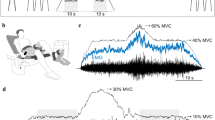Summary
Contracting muscle generates sounds which can be recorded easily by means of a microphone. To determine if a phonomyogram (PMG) can be used to monitor muscle force, a comparison was made between simultaneous recordings of PMG and monopolar electromyogram (EMG) from the isometrically contracting biceps brachii muscle and the external flexion force. Locations of the monopolar electrode and microphone were identified in relation to the motor point. Whatever the recording site, PMG amplitude was proportional to EMG amplitude and both showed a quadratic relationship to muscle force. Changes in the PMG spectrum with force were similar to those in EMG, i.e. the mean power frequency increased up to about 30% maximal voluntary contraction and then reached a plateau. De spite a slightly higher variability, PMG was shown to be a valid index of muscular isometric force. At the same force, the amplitude of both PMG and EMG was lower in the prone than in the supine position of the hand. This result indicated a selective recording of biceps brachii muscle activity.
Similar content being viewed by others
References
Bankov S, Jörgensen K (1969) Maximum strength of elbow flexors with pronated and supinated forearm. Dan Natl Assoc Infant Paralysis 29:3–11
Barry DT, Geiringer SR, Ball RD (1985) Acoustic myography: a noninvasive monitor of motor unit fatigue. Muscle Nerve 8:189–194
Basmajian JV, Latif A (1957) Integrated actions and functions of the chief flexors of the elbow: a detailed electromyographic analysis. J Bone Joint Surg 39A:1106–1118
Bierman W, Yamshon LJ (1948) Electromyography in kinesiologic evaluations. Arch Phys Med 29:206–211
Boudet de Paris M (1880) Recherches sur le bruit musculaire. CR Soc Biol 7ème série, 11:40
De Luca CJ (1985) Myoelectrical manifestations of localized muscular fatigue in humans. CRC Crit Rev Biomed Eng 11:251–279
Foix C, Thévenard A, Dupasquier C (1923) Enregistrement du bruit musculaire par le galvanométre à corde et l'amplificateur à basse fréquence (phonomyogrammes). Données relatives à la contracture et à la contraction. Contraction cinétique et contraction statique (posturale). CR Soc Biol 89:733–735
Grimaldi FM (1661) Physicomathesis de lumine, coloribus et irride. Bononiae: Ex typographia Haeredis Victorij Benatij
Hagberg M, Ericson BE (1982) Myoelectric power spectrum dependence on muscular contraction level of elbow flexors. Eur J Appl Physiol 48:147–157
Kramer H, Küchler G, Bräuer D (1972) Investigation of the potential distribution of activated skeletal muscles in man by means of surface electrodes. Electromyography 12:19–27
Le Bozec S, Maton B, Cnockaert JC (1980) The synergy of elbow extensor muscles during static work in man. Eur J Appl Physiol 43:57–68
Lindström L, Petersen I (1981) Power spectra of myoelectric signals: motor-unit activity and muscle fatigue. In: Stalberg E, Young RR (eds) Clinical Neurophysiol. Butterworths, London, pp 66–87
Maton B, Bouisset S (1977) The distribution of activity among the muscles of a single group during isometric contraction. Eur J Appl Physiol 37:101–109
Maton B, Bouisset S, Metral S (1969) Comparaison des activités électromyographiques globale et élémentaire, au cours de la contraction statique volontaire. Electromyography 9:311–323
Moller E (1966) The chewing apparatus. (An electromyographic study of the action of the muscles of mastication and its correlation to facial morphology.) Acta Physiol Scand [Suppl 280] 69:1–229
Oster G (1984) Muscle sounds. Sci Am 250:108–115
Oster G, Jaffe JS (1980) Low frequency sounds from sustained contraction of human skeletal muscle. Biophys J 30:119–128
Simons DG, Zuniga EN (1970) Effect of wrist rotation on the XY plot of averaged biceps EMG and isometric tension. Am J Phys Med 49:253–256
Stokes IAF, Moffroid MS, Rush S, Haugh LD (1988) Comparison of acoustic and electrical signals from erectores spinae muscles. Muscle Nerve 11:331–336
Vigreux B, Cnockaert JC, Pertuzon E (1972) Factors influencing quantified surface EMGs. Eur J Appl Physiol 41:119–129
Woods JJ, Bigland-Ritchie B (1983) Linear and non-linear surface EMG-force relationships in human muscles. An anatomical/ functional argument for the existence of both. Am J Phys Med 62:287–299
Zipp P (1982) Effect of electrode geometry on the selectivity of myoelectric recordings with surface electrodes. Eur J Appl Physiol 50:35–40
Zuniga EN, Truong XT, Simons DG (1970) Effect of skin electrode position on averaged electromyographic potentials. Arch Phys Med Rehabil 51:264–272
Author information
Authors and Affiliations
Rights and permissions
About this article
Cite this article
Maton, B., Petitjean, M. & Cnockaert, J.C. Phonomyogram and electromyogram relationships with isometric force reinvestigated in man. Europ. J. Appl. Physiol. 60, 194–201 (1990). https://doi.org/10.1007/BF00839159
Accepted:
Issue Date:
DOI: https://doi.org/10.1007/BF00839159




